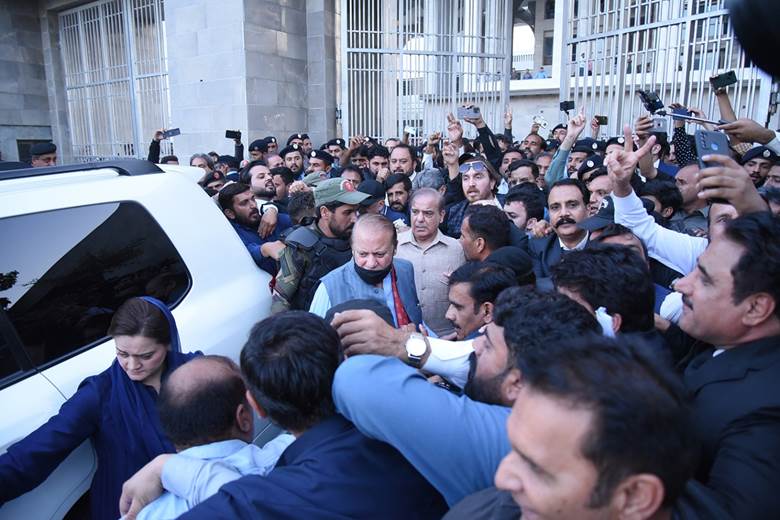

Former Prime Minister Nawaz Sharif arrives to appear before the high court in Islamabad on Oct 26, 2023 - Raja Imran Bahader/Pacific Press via Getty Images
The Road to Power in Pakistan Runs Through the Military
By Allison Meakem
Pakistan had been due to hold a vote last October but has now settled on February 8 as a polling date.
The Pakistani Constitution stipulates that an election be held within 60 days of the parliament’s dissolution on a regular schedule and within 90 days if the body is suspended before its term is up. Then-Prime Minister Shehbaz Sharif ended his term and stepped down on Aug. 9, 2023, handing control to a caretaker administration. But just before triggering the election countdown, Sharif’s government unveiled new census results; these are used to determine Pakistan’s voting constituencies. The country’s top electoral commission said it needed more time to redraw electoral maps based on the updated figures, and the contest was pushed to February.
“The opposition and its supporters believe the timing of the new census results was suspicious, and that it was used as a pretext to delay the elections to give the military more time to influence the electoral environment,” FP’s Michael Kugelman, the author of South Asia Brief , wrote in an email. The Pakistani military is known to be the country’s main power broker. As former Pakistani Ambassador to the United States Husain Haqqani explained in Foreign Policy last August, “[t]he military says it is not involved in politics, but politicians are still pursuing the generals’ approval.”
In April 2022, the military fell afoul with then-Prime Minister Imran Khan. Khan, whose litany of legal woes rival those of former US President Donald Trump in their complexity, has been in jail since August 2023 and is technically barred from politics for five years. But Khan and his backers call the many charges against him politically motivated. In late December 2023, Pakistan’s Supreme Court approved Khan’s bail in one case, and an Islamabad court stayed another trial until Jan 11, yet the ex-leader remains locked up related to other charges. “Khan’s cult-like supporters regard him as a figure who can save Pakistan from corrupt, dynastic politics,” Haqqani wrote.
Now, a defiant Khan is still leading his Pakistan Tehreek-e-Insaf (PTI) party’s list heading into next month’s vote. Authorities briefly sought to ban the PTI from printing its logo, a cricket bat, on ballots before a Peshawar court struck down the move. (Pakistan has high illiteracy rates, and logos help voters identify the correct candidate.) The state’s attempt to scrub the image may have been a response to the PTI’s popularity:
In a Gallup Pakistan poll conducted over June and July 2023, Khan earned a 60 percent approval rating, and 42 percent of respondents expressed an intention to vote for the PTI, much higher shares than were garnered by any other politician or party. The center-right Pakistan Muslim League (PML) earned 20 percent, and the center-left Pakistan People’s Party (PPP) followed with 12 percent. The PML and PPP are traditionally rivals but formed a marriage of convenience to oust Khan in 2022.
The brief tenure of the PML-PPP unity government was less chaotic than the three-and-a-half years that Pakistan experienced under Khan, but the country still faced its fair share of challenges. In addition to wrestling continued agitations from Khan and his supporters, Pakistan experienced “biblical” flooding in August 2022 and found itself in economic trouble. (Islamabad under its current caretaker government finally approved a bailout deal with the International Monetary Fund in November, a prospect Khan had spurned.) There’s also been an uptick in xenophobia against Afghan migrants. Last fall, the caretaker government—likely at the behest of the military—oversaw the expulsion of 1.7 million Afghans from Pakistan.
Shehbaz Sharif is not running as the PML’s top candidate in this election, however. That distinction goes to his brother, former Prime Minister Nawaz Sharif, who recently returned to Pakistan after spending four years in exile in the United Kingdom. Khan and Nawaz Sharif may be bitter foes, but they have one thing in common: Nawaz Sharif is also banned from politics thanks to a 14-year corruption sentence. But Pakistani authorities said Nawaz Sharif could not be arrested until he appears in court, and the PML successfully appealed his conviction and sentences, making him eligible for next month’s elections.
Even though Nawaz Sharif was once ousted in a military-backed coup, observers agree that the Pakistan Armed Forces appear to be once again backing the PML . That’s bad news both for Khan and PPP head Bilawal Bhutto Zardari, who most recently served as Shahbaz Sharif’s foreign minister. Kugelman said “the electoral playing field won’t be level,” with the PML enjoying a “big advantage.” Pakistan’s electoral commission has already been accused of redrawing electoral maps with the new census data to favor the PML.
Even so, public opinion seems to be tilting in the PML’s direction: In the Gallup poll, a plurality of voters said they would cast ballots for the PML, rather than the PPP, if Khan’s PTI did not participate in the next elections.
The weeks ahead are likely to feature a great deal of political and legal machinations from all of Pakistan’s major parties. In mid-December 2023, Pakistan’s Supreme Court announced that it would form a committee to adjudicate political bans —a move that Kugelman wrote “seems to pave the way for Nawaz Sharif … to run for office.” Lo and behold, the PML announced just weeks later that Nawaz Sharif would be its top candidate in the Feb 8 vote.
If elections go ahead, Pakistanis will vote for all 342 seats in the National Assembly, the lower House of parliament, most of which are in single-member constituencies. The remaining seats are awarded through a proportional, party-based allocation system. That is, if the military approves. – Courtesy Foreign Policy
(Allison Meakem is an associate editor at Foreign Policy)

